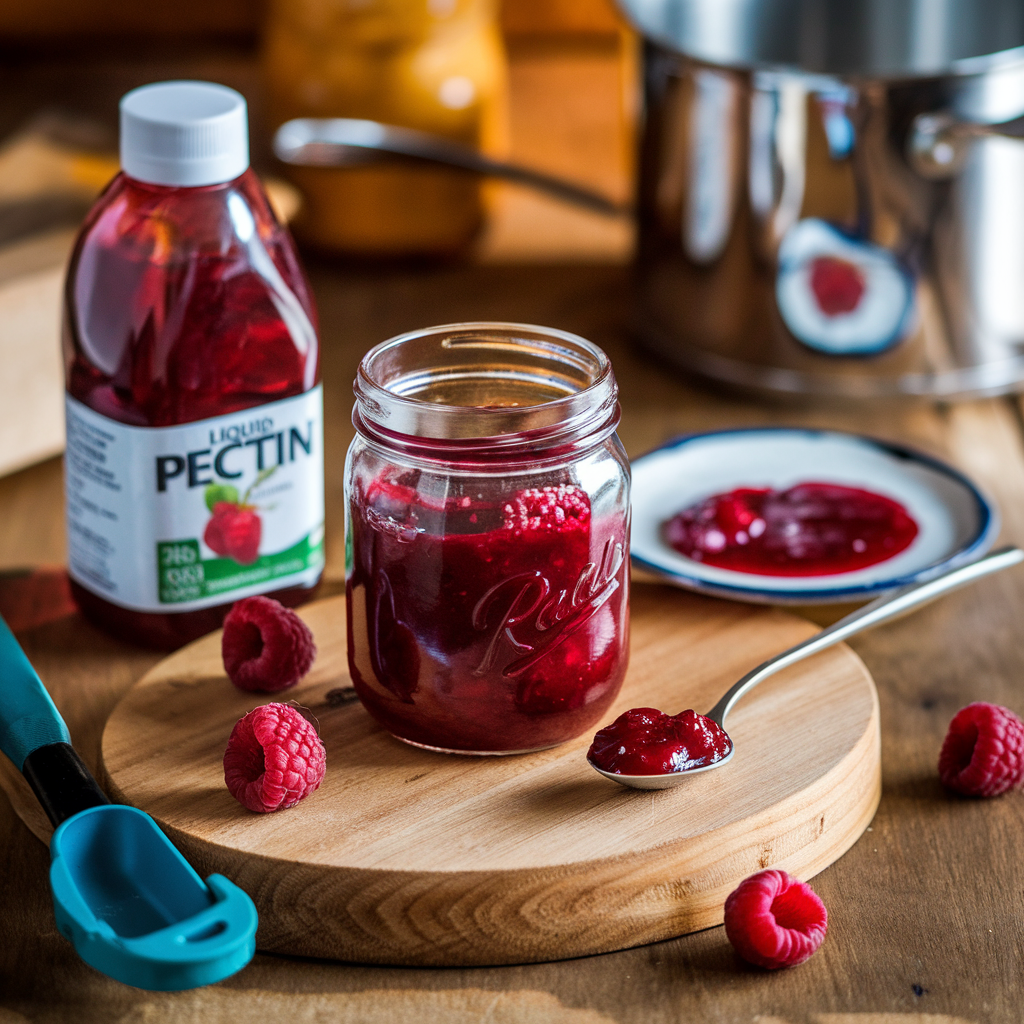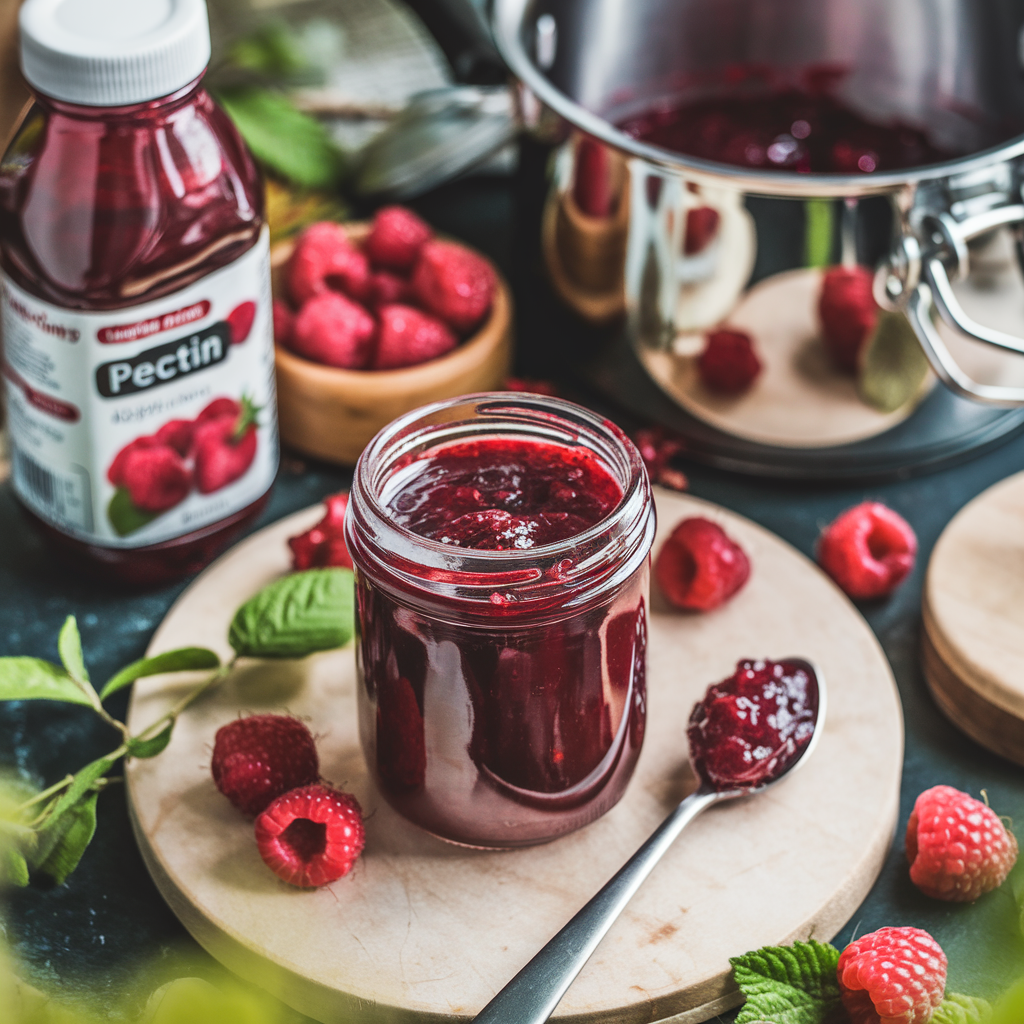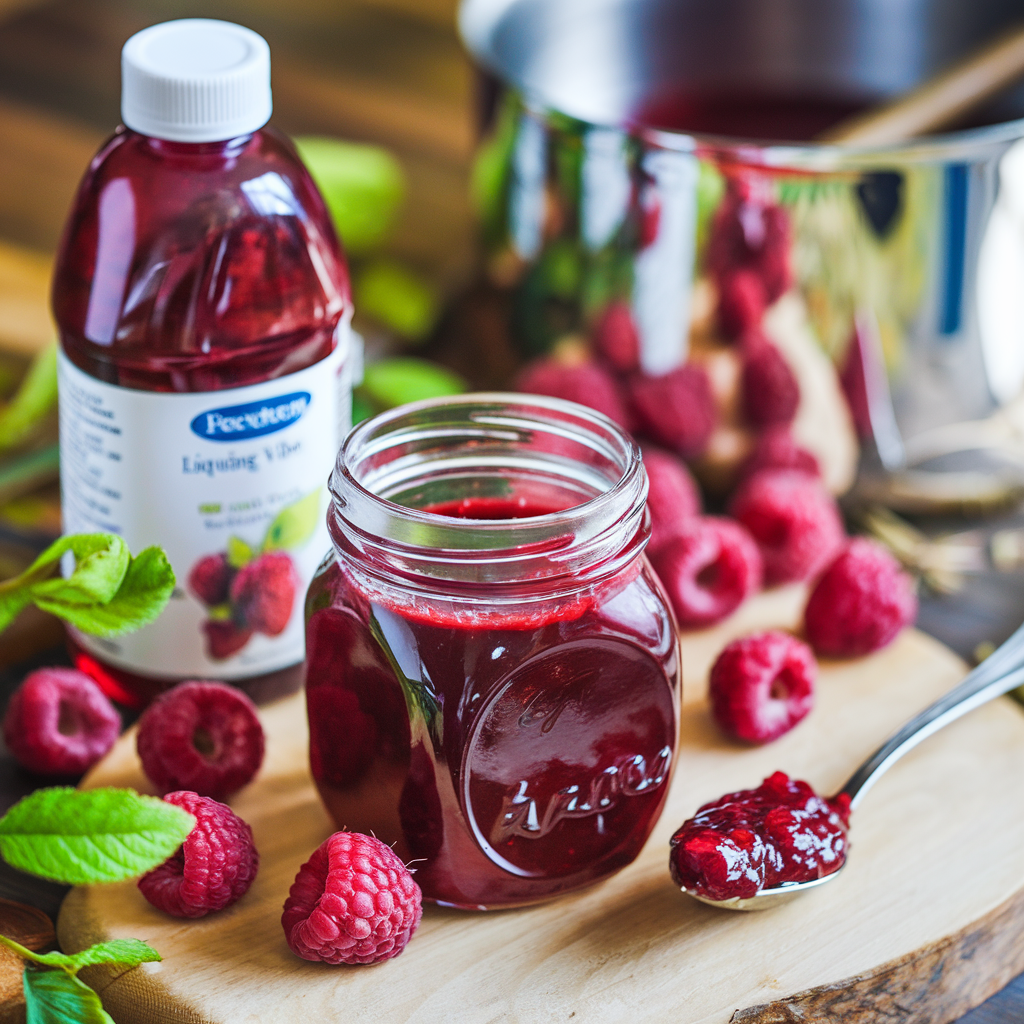Introduction
Making homemade raspberry jam is one of the most satisfying and delicious kitchen projects. However, it can be challenging to get the texture just right, especially when it comes to using pectin. Liquid pectin is a popular choice when making raspberry jam, but knowing exactly how much to use can make a big difference in your jam’s consistency. This article will guide you through the process of determining how much liquid pectin to use in raspberry jam, along with tips and tricks to ensure perfect results every time.
What Is Pectin and Why Do You Need It?
Pectin is a natural substance found in the cell walls of fruits. It’s responsible for helping fruits set and thicken into a gel-like consistency when cooked. It’s an essential ingredient in making jam, jelly, and preserves. For raspberry jam, liquid pectin helps the jam set properly by promoting the gelling process. Without it, your jam may turn out too runny or fail to gel at all.
There are two main types of pectin: liquid pectin and powdered pectin. While powdered pectin is the more common choice in many jam recipes, liquid pectin has a faster set time and can be easier to use in certain recipes. Understanding the right amount of liquid pectin to use is critical to achieving the right consistency.

The Role of Liquid Pectin in Raspberry Jam
Liquid pectin works by interacting with sugar and acid to form a gel when combined with fruit juice or puree. This process is essential for making a firm, spreadable jam. In the case of raspberries. The natural pectin content in the fruit is lower compared to apples or citrus fruits, which is why you need to add extra pectin to achieve the desired consistency.
When making raspberry jam, the amount of liquid pectin you use will depend on several factors:
- The ripeness of your raspberries: Riper raspberries have higher pectin content, which might reduce the need for additional pectin.
- The type of pectin: Different brands and types of liquid pectin may have different concentrations or instructions for use.
In general, the standard recommendation for most liquid pectin brands is to use 1 pouch (or 6 fluid ounces) of liquid pectin for 4 cups of crushed raspberries and 5 cups of sugar. However, it’s important to follow the manufacturer’s instructions for the brand of liquid pectin you’re using.
How Much Liquid Pectin to Use in Raspberry Jam?
When it comes to how much liquid pectin to use in raspberry jam, it’s important to follow the specific instructions from your pectin manufacturer. However, here’s a general guide:
- Standard Proportion for Jam: Use 1 pouch (6 oz) of liquid pectin for about 4 cups of mashed or crushed raspberries.
- Sugar-to-Fruit Ratio: The typical ratio is 5 cups of sugar to 4 cups of raspberries for a balanced, sweet jam with proper gel consistency.
- Adjusting for Thicker Jam: If you prefer a thicker jam, consider using a little less sugar and more pectin, but be cautious—adding too much pectin can result in a jam that’s overly firm or too gummy.
Step-by-Step Guide to Making Raspberry Jam with Liquid Pectin
Here’s a step-by-step guide to ensure your raspberry jam turns out perfect every time:
Ingredients:
- 4 cups of crushed raspberries
- 5 cups of sugar
- 1 pouch (6 oz) of liquid pectin
- 1 tablespoon of lemon juice (optional, but recommended for extra acidity)
Instructions:
- Prepare Your Jars and Lids: Sterilize your jam jars and lids by boiling them for 10 minutes. Set aside to dry.
- Mash the Raspberries: Mash or crush the raspberries using a potato masher or food processor. Measure the mashed fruit to ensure you have the correct amount.
- Combine Fruit and Sugar: In a large pot, combine the crushed raspberries and sugar. Stir until the sugar is fully dissolved.
- Boil the Mixture: Bring the mixture to a full rolling boil over high heat, stirring constantly. A rolling boil is one that doesn’t stop bubbling when stirred.
- Add Liquid Pectin: Once the mixture has reached a rolling boil, add the liquid pectin, stirring to incorporate. Allow the mixture to boil for an additional 1-2 minutes.
- Test for Set: To test if your jam is set, place a spoonful of the jam on a cold plate and let it sit for a minute. Run your finger through the jam. If it wrinkles and doesn’t run, it’s ready. If not, continue boiling for another minute and retest.
- Fill the Jars: Carefully ladle the hot jam into your sterilized jars, leaving about ¼-inch of headspace. Wipe the rims of the jars with a clean, damp cloth before sealing them with lids.
- Process the Jars: Process the jars in a boiling water bath for 5-10 minutes to ensure they seal properly. Let them cool completely before storing.

Tips for Success
- Choose the Right Pectin: Make sure you’re using a high-quality liquid pectin, as the brand and quality can affect the gelling process. Some pectins may require different quantities or steps.
- Use Fresh, Ripe Raspberries: Overripe or underripe raspberries may not provide enough natural pectin to help the jam set. Aim for firm, fully ripe berries.
- Don’t Skip the Boil: Ensure your jam reaches a full rolling boil before adding pectin. This step is essential for the pectin to activate properly.
- Adjust Consistency: If your jam isn’t setting, you can always add a bit more liquid pectin and re-boil it. However, be cautious not to add too much pectin, as it can make the jam too firm or cause an undesirable texture.
Common Mistakes to Avoid When Making Raspberry Jam
- Not Using Enough Pectin: If you don’t use enough liquid pectin, your jam may not set, leaving you with a runny or syrupy result.
- Not Boiling Long Enough: If the jam doesn’t reach a rolling boil before adding the pectin, the pectin won’t activate properly, affecting the jam’s texture.
- Overcooking: Boiling your jam for too long can result in a jam that is too thick or caramelized. Always test for set and stop boiling as soon as the desired consistency is reached.
- Skipping the Water Bath: For safe, long-term preservation, always process the jars in a water bath to ensure a good seal.
Can You Use Liquid Pectin for Other Fruit Jams?
While this guide focuses on raspberry jam, liquid pectin can be used in other fruit jams as well. The key is to follow the manufacturer’s instructions and adjust for the specific fruit you’re using. For instance:
- Strawberry Jam: Like raspberries, strawberries are low in natural pectin, so liquid pectin is a great choice.
- Peach Jam: Peaches may require a bit more pectin since they have a higher water content than some berries.
- Mixed Berry Jam: For mixed berry jams (e.g., blackberry, blueberry), liquid pectin works wonders to ensure the jam sets properly.
Is Liquid Pectin Better Than Powdered Pectin?
Both liquid pectin and powdered pectin are effective for making jam, but each has its benefits:
- Liquid Pectin: Liquid pectin is easier to work with because it doesn’t need to be mixed with sugar first and activates more quickly. It’s ideal for recipes with high sugar content like raspberry jam.
- Powdered Pectin: Powdered pectin tends to be more stable and is better for low-sugar jams. It also allows for a more gradual gelling process.
FAQs About Using Liquid Pectin in Raspberry Jam
Making raspberry jam with liquid pectin can be a new experience for some. And there are often many questions that arise during the process. Below are some of the most frequently asked questions about using liquid pectin in raspberry jam, along with detailed answers to help ensure your success.
1. How much liquid pectin should I use for 3 cups of raspberries?
If you’re working with 3 cups of raspberries, you can use 3/4 pouch (approximately 4.5 oz) of liquid pectin. This amount typically works well for achieving a good set, particularly when paired with the right amount of sugar. However, always refer to the instructions on the liquid pectin packaging, as different brands may have slightly different recommendations.
If you’re making a smaller batch of jam, you might need to adjust the quantities of other ingredients as well, but maintaining the correct ratio of fruit to pectin is essential for getting the perfect jam consistency.
2. Can I make raspberry jam without pectin?
Yes, you can make raspberry jam without pectin, but the results may vary. Without added pectin, the natural pectin content in the raspberries themselves may not be enough to give your jam the desired thickness and set. To compensate for the lack of pectin, you can try one of the following alternatives:
- Cook the jam longer: By boiling the fruit and sugar mixture for a longer time, you can allow the natural pectin in the fruit to work and thicken the jam. Keep in mind, this method will take more time, and you must frequently test the jam for set by placing a small amount on a cold plate to check for consistency.
- Use natural pectin sources: You can add other fruits that are naturally high in pectin, such as apples, citrus peels, or even a bit of lemon juice. These additions can help the raspberry jam set more effectively without the need for added pectin.
While these methods can work, they often result in a different texture than jams made with liquid pectin. If you prefer a consistent result, using liquid pectin is the more reliable option.
3. What happens if I add too much liquid pectin?
If you add too much liquid pectin to your raspberry jam, you might end up with a too-thick or overly firm jam. Adding excessive pectin can cause the jam to set too firmly, creating a jelly-like texture instead of the spreadable consistency most people desire in jam. In some cases, it can even result in a rubbery or gummy texture, which is unappealing for many.
To avoid this, always follow the recommended measurements on the pectin packaging. If you’re unsure, it’s safer to use a little less pectin and adjust during the cooking process, rather than using too much. If your jam is too firm after the initial cooking, you can always reheat it and add a small amount of additional liquid (such as water or lemon juice) to loosen it up. You can also stir in a small amount of additional pectin to fix a jam that is too runny.
4. Can I substitute liquid pectin with powdered pectin in raspberry jam?
Yes, you can substitute liquid pectin with powdered pectin, but it’s important to adjust the quantities accordingly. Powdered pectin is more commonly used in many jam recipes, and it typically requires a slightly different approach:
- Use the correct ratio: Generally, 1 pouch (6 oz) of liquid pectin is equivalent to 1-1.5 tablespoons of powdered pectin. Check the package of the powdered pectin you’re using for specific conversions.
- Add the powdered pectin at the right time: When using powdered pectin, it is usually added before the boiling process—mixing it with the sugar before bringing the fruit mixture to a boil. Liquid pectin, on the other hand, is added after the boiling stage.
- Check the texture: Because powdered pectin typically requires more sugar to set the jam, be sure to check the consistency of the jam as it cooks. You may need to adjust the sugar levels to get the desired result.
Substituting powdered pectin for liquid pectin can work well, but it’s important to follow the specific instructions for each type, as the preparation steps and timing may differ.
5. Can I reduce the amount of sugar in raspberry jam when using liquid pectin?
Yes, it is possible to reduce the amount of sugar in raspberry jam when using liquid pectin, but you should do so carefully. Traditional jam recipes often rely on a high sugar-to-fruit ratio to help the jam set, but there are options for reducing sugar without sacrificing quality.
- Use low-sugar pectin: If you want to make a low-sugar raspberry jam, look for low-sugar liquid pectin options, which are specifically formulated to set with less sugar. These pectins may require a different ratio of fruit to pectin, so follow the packaging instructions carefully.
- Reduce sugar gradually: If you’re using regular liquid pectin and want to reduce the sugar content, start by cutting the sugar by a small amount—no more than 1/4 or 1/3 of the original amount—and test the consistency as you go. Keep in mind that reducing sugar too much can prevent the jam from setting properly.
- Use sweeteners: You can also experiment with sugar substitutes, like honey or stevia, to reduce the sugar content. However, these sweeteners may not provide the same gelling properties as sugar, so it’s best to pair them with a high-pectin fruit or use a special pectin product designed for low-sugar jams.
6. How do I store my raspberry jam made with liquid pectin?
Proper storage is crucial to ensure that your homemade raspberry jam remains fresh and safe to consume. Here are some tips for storing your jam:
- Refrigeration: If you’ve made a small batch of jam that you plan to use within a few weeks, you can simply store it in the refrigerator. Make sure the jars are sealed tightly to avoid contamination.
- Canning: For long-term storage, you can process your jars in a boiling water bath for 5-10 minutes after filling them. This method will create a vacuum seal, allowing your jam to last for up to a year when stored in a cool, dark place. Always check the seal before storing to ensure it is intact.
- Freezing: If you want to store jam for even longer, you can freeze it. Just be sure to leave some headspace in the jars or containers, as the jam will expand as it freezes. Thaw in the refrigerator before use.
Conclusion:
Using the right amount of liquid pectin in your raspberry jam is essential to achieving the perfect consistency. By following the guidelines in this article and understanding the balance between fruit, sugar, and pectin, you can create delicious, spreadable raspberry jam every time. Whether you’re a jam-making novice or an experienced canner, knowing the precise amount of liquid pectin to use is the key to making jams that taste like they came straight from the farm. Happy jamming!

